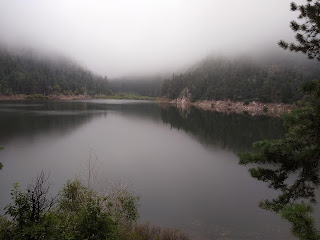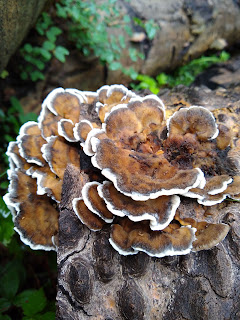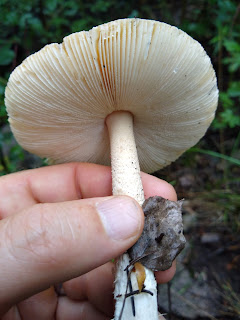
The area is huge, with few people and (mostly) unspoilt. Like most places, you have to be prepared to travel a ways to get away from the crowds.
The area has periods of heavy mists that drip moisture. The very air condenses onto the trees and the soil is perpetually damp under the plants and mosses that grow everywhere. Life is literally oozing out of the ground.Insects would normally not do well in damp and cold conditions. This bumblebee is stiff and cold as well as wet. It is alive and moving, but very slowly.
The butterflies also are cold and slow. Notice the drops of water on the wings. These insects are waiting in a torpor for the fierce sun to come out and dry off everything. By waiting out the cold conditions on their feeding spots, they are ready to collect nectar as soon as conditions are ideal. This one is called a Police Car Moth, go figure.
The hiking is spectacular, but I am not here to sell a travel blog. The best part is that the 2 mile approach road is not for the faint hearted. Do not try it in a passenger vehicle. It also sucks that rented ATV's have torn up and created their own trails along the approach road.
The walking trails are narrow and dangerous in places. The early morning was by far the best time to see the misty views. People are usually late risers unless they have camped at the trailhead.
By the afternoon the fierce sun was hammering down and the wildflower fields were alive with insects. Although the diversity did not appear to be very high.
There are very few trails in this area (officially) and the steep terrain is great at keeping people away. The elevation gain was about 1000 feet. This area apparently is not stocked with fish, thankfully. Fishing tackle festooned the branches all round the banks.
This flower has some beautiful symmetry and appears to be adapted for "buzz pollination" meaning it likes bumblebees, which were bountiful.
At the higher elevations, the spanish moss was very thickly festooned from the trees. They definitely helped create a quiet and sombre atmosphere, like a cathedral.
There were many familiar edible plants, such as strawberry, raspberry, currant bushes, but also elderberries.
Never eat plants you are not more than 100% certain of. I did try a few raspberries and currants. This was identified as a chokeberry. I'm not convinced, and gave them a wide berth. Choke berries are edible, but not a person's first choice, hence the name.
Daisies were a common plant in the meadows. However this was the only spider (a crab spider) I saw. There was also very few spiderwebs as they don't work so well in the mist. So the spiders that are around are usually ambush huntersBeetles tend to hide in heavy cover and come out when the sun comes out. Their dark color means they absorb heat well. They are important pollinators, but beetle are diverse enough that there will be a species that fills just about every role in nature.
Not too sure what this butterfly species is. There was a lot of them around in the warm meadows.
This butterfly took quite some work and a lot of luck to snap a picture of, as the heat had re-invigorated the whole population and they were in quite a frenzy. Ended up being a pretty standard fritillary species, oh well.
This smaller butterfly is a purplish copper. Butterfly namers tend to be focused on families of names. There are many types of coppers.
This is some sort of Crambid snout moth that bores holes in grass stems. This one is looking a little bedraggled.
This bee is holding onto that flower with a death grip until it is warm and dry enough to continue feeding. I saw many insects jockeying for position on the same coneflower
This impressive wasp fell out of the foliage while I was checking the raspberry bush for fruit. Appropriately enough, it is called the raspberry crown borer.
Now the bee has dried out, it is happily digging around for nectar. This is a rust belted bumblebee. It is usually found much further north of here.
The range of fungi was pretty spectacular. These had a slimy top and were growing on a dead tree. Mushroom season appear to be about to end.this appears to be a very widespread mushroom. The gills are important for identification, but I would never try eating any of them.
In the Rio Grande valley we tend to see small mushrooms, but some of these fruits can attain pretty large sizes. This monster is unidentified at the moment.
The stalk of a mushroom appears to be optional, as evidenced by all the shelf like this one.
Mushrooms seem to incredibly widespread when the conditions are right. Those gills are how the spores are released, but they also serve as structural support for the cap.
This little one might be called the deceiver. Apparently it can be hard to identify correctly. Not one to practice with.
A young Amanita muscaria subsp. flavivovata. They are not deadly poisonous, but are unpleasant. This is the fairy tale version of the family of mushrooms that covers about 14,000 described species.This weird fungus is called the violet crust. It is usually found in complex communities with other species. Here, there are some orange species mixed in with it. These organisms work hard to break down the cellulose they use to produce energy.
This little egg is an edible (pretty sure on this one) puffball. When mature, these puff spores into the air when stepped on. This one is solid inside. Mushrooms are composed of chitin, glucans and protein. There are no carbohydrates here.
Back in the river valley, I found these stretchberries. I had never heard of this species before. Apparently they are popular with wildlife but there is not much out there about the species.
Goldenrod, the flowers are clear sign of the height of summer. Soon the nights will become colder and the days have already begun to shorten again.
This very round beetle is a species of darkling beetle found down on Candelaria farm. I haven't found them in Corrales. But apparently we have javelina in the bosque as well, so anything is possible.
Juvenile bullfrogs are appearing in the ditches as irrigation continues into the fall. The juveniles are impressively energetic, as anyone who has tried to catch one during the day can attest...
This tiny translucent caterpillar reminds me of the character "Slimer" from the Ghostbusters episodes.
Turtles are impressively designed. They are well adapted to a life of sunbathing and lounging by the pool. They are also a lot faster than they seem.
While the valleys have much less diversity of fungi, these Conecaps are usually found on the over watered lawns of schools as the school season begins again.
I think this cluster of caterpillars are from a type of tiger moth. Their tiny hairs are usually enough to prevent birds being to interested in them.
This skipper has just emerged from its cocoon and the wings are still stretching and filling with hemolymph before it begins its aerial life
New
Mexico trees are not very good for lumber. The ponderosa and aspens in
the mountains are tall trees, but not very good for building. The
cottonwoods and elms in the valleys are not exploited either. This is
good for conservation, but having no value means trees are not exactly
valued or protected here. Handling a large tree is difficult, but I always wonder if maybe
there is a better use for large wood than turning it into wood chips
for mulch? Most of that ends up in the waterways too.










































No comments:
Post a Comment